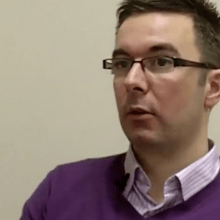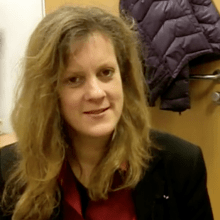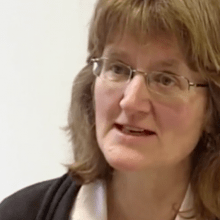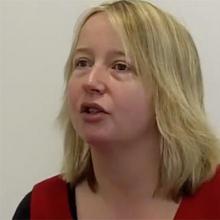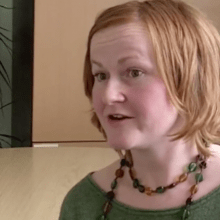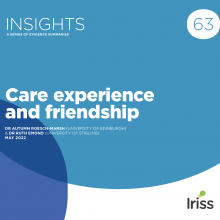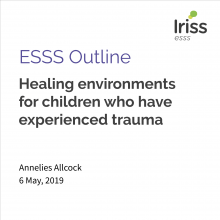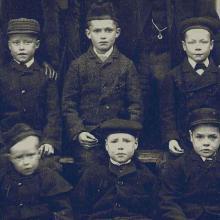Zachari Duncalf, Research Fellow at CELCIS, speaks about a pilot project - Taking Place Seriously - that was undertaken to understand how young people feel about living in a children's home and what the young people liked or disliked about their surroundings. This recording sits within the parameters of child care as part of the collection.
The project involved four children from one children's home care home in Scotland and another in England, and four staff from each of the homes. It allowed young people to think creatively and differently about how the research was conducted and gave the staff the opportunity to conduct research in ways other than a questionnaire format. Young people and staff were supported to take the researchers on a tour of their living and work place, showing them what was important to them in this space. Young people and staff also took photographs of things that had particular meaning to them. The young people and the staff were then brought together to talk about what had meaning for them, and there were interesting differences between what was considered to have meaning.
This research helps us in thinking about how children's homes are designed and the meanings attached to this. There were specific findings about objects and lighting for instance, which can be drawn on to inform the design of similar spaces in the future.
Further resources
Children in Scotland (2011) Making space: Architecture and design for children and young people, Edinburgh: Children in Scotland
Clark, A (2010) Transforming children's spaces: Children's and adults' participation in designing learning environments, London: Routledge
Stevens, I (2006) Consulting youth about residential care environments in Scotland, Children, Youth and Environments, Vol. 16(2), 51-74.
My name is Zachari Duncalf, I am a Research Fellow at the Centre for Excellence for Looked After Children in Scotland, CELCIS, which is based here at the University of Strathclyde. We are involved in a wide range of research and teaching projects across the sector concerning looked after children and young people in care and care leavers. Recently we have just finished a pilot project called 'Taking Place Seriously', and this was a project which focused on one children's home in Scotland and one children's home in England where we accessed 4 young people in each and 4 staff members in each. This was an innovative project that allowed young people to think differently and creatively about how they might be involved in research, and for staff to also think beyond the original questionnaire and the interview technique.
So we set up a number of sessions in the home throughout the day and the evening where we facilitated tours of the home, so this allowed young people and staff members, individually, to take us on a tour of their living and workplace. On this tour they explained to us what was important to them about the space and place and what gave them a sense of meaning - positively or negatively, that impacted on how they lived and worked in that place. In addition to this talking and the tour, they also took photographs - about 8 to 10 photographs of things that had particular meaning to them.
These photographs ranged from the kettle because it was seen as a central point as a home where everybody congregated, talked about their day and really interacted with others and made cups of tea and coffee for other people.
They also included specific pictures of their rooms, because their rooms were their own rooms so they brought their own furniture, their own duvets, painted their own walls - which was quite unusual for a setting in a children's home, which are quite staid or generic. So they felt it was their own home, and not just somewhere that they were placed for a certain period of time. In relation to the staff, they also felt that this place had meaning for them and was able to give them a sense of homeliness as well as a positive workplace. So this included pictures of up-lighters rather than strip lights, so it made a more comfortable working environment. Cushions and the living space, which allowed them to work with the young people more comfortably and sit with them and enjoy watching TV with them rather than being separated and segregated spaces. So this was a project that really was piloted for us to think about the methodology and for us to think about how we might get different kinds of answers and different interactions around something other than a questionnaire in an interview.
We did use traditional methodology in this research as well, so we brought the young people and the staff together to show each other their photos and what gave each of them meaning. And it was quite interesting how staff thought something was meaningless and young people thought it was quite meaningful, and vice versa as well. So actually just having a talk about the space in which they both worked and lived enabled them to better understand how they used the space, what spaces were problematic and how they then might change that space to make it a more positive and collective working and living environment. The importance of this research was to think about how these places are designed, what they are used for and how we get a sense of meaning from them, in order to think about things, for example, how young people and staff attach themselves to place and why having a numbers of placement moves can mean that you are often disjointed and you don't feel like you belong somewhere. So we have got some sense of objects and light and specific areas that we could then allow others to think about how they may design similar spaces in the future.
We also wanted to understand a bit more about a sense of belonging as well, so giving staff and young people to find common ground and common spaces that they found comfortable and enjoyed those places. So the impact of this research and the future prospects for this research are two-fold really. Firstly, we hope to do this on a bigger scale, so now we have ironed out the method and we have looked really more into what worked and what didn't work, particularly as the group of young people we were working with were older teenagers, so having to then go into work with other children's homes where there may be younger people, how we could adapt that methodology to make, again, them more able to actually talk about and relay their experiences, rather than feel quite disjointed in terms of language and written expression, which we usually expect young people to be able to do in questionnaires and interviews. So we hope to then take this into 4 children's homes in Scotland and 4 in England, and really look quite in-depth and spend quite a lot of time, a number of days and evenings, allowing young people and staff to pick up and take off at different points on different tours.
So it's not a case of we go in, we ask a questionnaire and we leave - but actually so "we can have a 5 minute tour now", and "you want to follow up on that a bit later - that's fine too", because different places also have different meanings at different times of the day as well. So there were lots of things that came out of the research that we haven't really thought about, but as it's piloted, it gives us the opportunity to think about those things on a bigger scale and to have thought about our methodology as well as our thoughts behind the findings as well.
